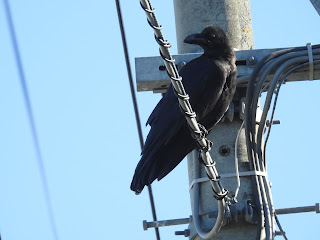My family and I recently travelled to Japan. We spent our first few days in Kyoto, followed by a day in Tokyo, 5 days in Hokkaido and another day in Tokyo.
The morning of our first day in Kyoto was spent walking to a stretch of the Kamo River, for our first taste of Japan's birds. Throughout the city, Eurasian tree sparrows were extremely common, along with large-billed and carrion crows. Once we arrived at the river, I immediately spotted a beautiful Japanese wagtail searching a nearby pile of rocks for food. The river also held several white wagtails, mallards, grey herons, great egrets and little egrets. While walking, a black-eared kite flew overhead, mobbed by several crows. Finally, as we left the river a lone white-cheeked starling was seen.
JAPANESE WAGTAIL Motacilla grandis
CARRION CROW Corvus corone orientalis
WHITE WAGTAIL Motacilla alba lugens
MALLARD Anas platyrhynchos
GREAT EGRET Egretta alba
GREY HERON Ardea cinerea jouyi
LARGE-BILLED CROW Corvus macrorhynchos japonensis
Our next destination was the Imperial Palace, which we reached quickly by subway. In the gardens, there were several large, mixed flocks of eastern great tits and long-tailed tits. 2 Japanese pygmy-woodpeckers were the highlight of the day. In the palace itself were several grey herons and 2 Oriental turtledoves.
LONG-TAILED TIT Aegithalos caudatus trivirgatus
JAPANESE PYGMY-WOODPECKER Yungipicus kizuki nippon
ORIENTAL TURTLEDOVE Streptopelia orientalis
On our second day in Kyoto, we caught the train to Nara and visited Nara Park. Though this was not very productive bird-wise, it gave us close views of the resident, tame Sika deer.
SIKA DEER Cervus nippon
On our third day, we visited Arashiyama Monkey Park and a nearby bamboo grove. Along with many Japanese macaques, a small feeding flock of Japanese white-eyes and long-tailed tits was seen, along with a single Japanese pygmy-woodpecker. On our way down from the park, we saw our first brown-eared bulbuls. The grove itself held no wildlife of interest, though a lone Temminck's cormorant flew overhead as we were walking.
JAPANESE MACAQUE Macaca fuscata
BROWN-EARED BULBUL Hypsipetes amaurotis
Our final day in Kyoto was spent visiting the Hiroshima Peace Museum, and, aside from a few Eurasian tree sparrows, no birds were seen.
























































